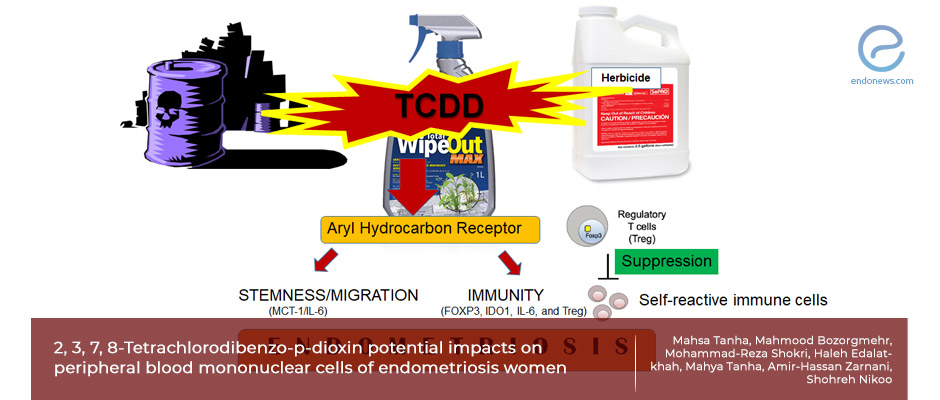Herbicide Alters Immune System on the Route to Endometriosis
Jan 5, 2022
The mechanism of dioxin causing endometriosis might be immune system alteration
Key Points
Highlights:
- The research highlighted the mechanism of an environmental pollutant and herbicide Tetrachlorodibenzo-p-dioxin (TCDD) and its receptor aryl hydrocarbon receptor (AHR) on causing endometriosis: Acting through the regulation of immune cells.
Importance:
- The detrimental effect of dioxin is not only on healthy women, it also may be a cause or enhancing matter on endometriosis.
What's done here:
- The study included peripheric blood samples from 24 women, 12 have histological confirmation for stage 4 endometriosis and the rest do not have endometriosis (control group).
- From the peripheral blood, immune effector cells [regulatory T cells (Tregs)] and the expression of AHR, FOXP3, and indoleamine dioxygenase were analyzed in the absence and presence of TCDD(herbicide).
- IL-6 cytokine levels in the supernatant of peripheral blood mononuclear cell cultures were measured.
- Also, the menstrual blood of 6 healthy women has been taken in order to extract menstrual blood stem cells.
- The impact of TCDD-treated peripheral blood mononuclear cells on menstrual blood-derived stromal stem cells, and cytokine production of stem cells after TCDD exposure have been analyzed.
Key Results:
- The Aryl Hydrocarbon Receptor and indoleamine dioxygenase levels were low in endometriosis; explained as lower immune suppression capacity of immune cells in endometriosis patients.
- Interestingly, herbicide treatment increased AHR, FOXP3, Iindoleamine dioxygenase, IL-6, and Treg levels in the endometriosis group causing an encouraging both inflammatory and anti-inflammatory processes.
- TCDD-treated PBMCs increased the migration capacity of MenSCs and up-regulated MCP-1 and IL-6 levels in the PBMCs/MenSCs co-culture meaning the migration boosting effect of stem cells of endometrium in endometriotic patients.
Limitations:
- The study was conducted with peripheric blood immune cells and endometriotic stem cells from healthy women and related to the possible local changes on endometriotic tissues and stem cells on endometriosis patients the results might differ accordingly when applied from the endometrium and endometriotic tissue of endometriosis patients.
Lay Summary
A popular environmental pollutant and herbicide named 2, 3, 7, 8-Tetrachlorodibenzo-p-dioxin (TCDD) and its receptor named aryl hydrocarbon receptor (AHR) have been suggested for causing endometriosis, but the mechanism was not clear.
In the study conducted by Mahsa Tanha et al, the researchers investigated the immunologic pathways that TCDD herbicide and its receptor AHR use to cause endometriosis. The study examined the peripheral blood samples from 24 women, half with histological confirmation for stage 4 endometriosis, and the rest have undergone laparoscopy for tubal ligation and do not have endometriosis, used as controls.
From the blood, by examining the regulatory T cells and AHR, FOXP3, indoleamine dioxygenase expression, as well as IL-6 cytokine levels from the peripheral blood mononuclear cell cultures in the absence and presence of TCDD, the authors evaluated the potential immunomodulatory effects of TCDD herbicide. The migration capacity of menstrual blood stromal stem cells was measured from the menstrual blood of 6 healthy women. The impact of TCDD-treated PBMCs on menstrual blood-derived stromal stem cells (MenSCs) and monocyte chemoattractant protein-1 (MCP-1) and IL-6 production of stem cells after TCDD exposure have been analyzed.
The AHR receptor and indoleamine dioxygenase levels were lower in endometriosis patients peripheral blood cells; explained as low immune suppression capacity of immune cells of endometriosis patients.
Interestingly, TCDD herbicide treatment increased AHReceptor, FOXP3, indoleamine dioxygenase, IL-6, and Treg levels in the endometriosis group causing an encouraging effect on both inflammatory and anti-inflammatory processes. TCDD herbicide-treated immune cells increased the migration capacity of Menstrual Stem Cells, up-regulated cytokines (MCP-1 and IL-6) levels in the co-culture meaning the migration boosting effect of stem cells of the endometrium in endometriotic patients.
As the authors used stem cells from healthy women this might be explained as the starting point effect of TCDD herbicide causing endometriosis from nothing and also the authors concluded the mechanism of TCDD while causing endometriosis is related to its immune system dysregulation effect. This paper has recently been published in the "Journal of Reproductive Immunology".
Research Source: https://pubmed.ncbi.nlm.nih.gov/34781065/
tcdd endometriosis immune regulation

